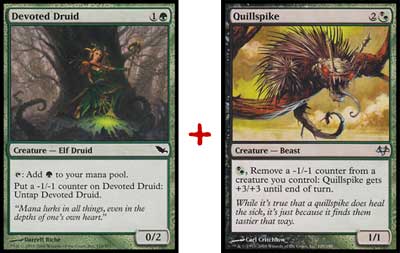 I am a Math Teacher at a high school in the US Midwest. I have loved this game since the Spring that Judgment came out. That is when a group of students taught me how to play and let me starting building decks from their shoe boxes full of cards. Now I’m the one with the boxes and I am teaching students how to play.
I am a Math Teacher at a high school in the US Midwest. I have loved this game since the Spring that Judgment came out. That is when a group of students taught me how to play and let me starting building decks from their shoe boxes full of cards. Now I’m the one with the boxes and I am teaching students how to play.
You'll notice that I say ‘we’ and ‘our’ articles. I don’t do all of the writing nor do all of the ideas come from my head. The students in school here do a lot of the leg work. I’m just a funnel for their creativity. That means a large random mix of decks will be produced. Whether you’re a Timmy, Johnny, or Spike you’ll find it in our classroom.
Today I’m going to officially write down a lesson that I give to many a student when they start designing their own decks. After learning the game we all go through that phase of inserting cards at random just because they’re cool cards and they match the colors of a deck but at some point we start looking for consistency and a centralized theme about our deck. It is then that I will deliver the following lesson. I can’t claim ownership of the idea and I picked it up so long ago I can’t even cite the source but I’ll resurrect it now for you.
When you design a deck all you really need is nine cards. That’s right, just nine. Building a deck requires 60 but designing one only takes nine. The flaw I see in most of my students is that they just put any cool card into their deck because they like it. Often going over the 60 count, or worse, replacing a land with the aforementioned card.
For those of you with any mathematical understanding going over 60 decreases the chance of drawing any card you may need and replacing a land with a spell decreases the chance of having enough mana to cast your spells. If a deck is overstuffed or starving for mana it will lose and that super cool mythic rare you have just gets shuffled over and over again.
It isn’t really something to write an article over but I’m sure that everyone reading this has already learned to stay at 60 cards and to be mindful of you mana count. After my beginning students learn that lesson and are ready to design a deck I try to steer them into the “Rule of Nine”.
Basically the Rule of Nine says that they way to begin a deck design to start with a list of just nine cards. Each of these cards becomes a full play set (4 cards) yielding 36 cards in your deck. After that place 24 basic lands and you have a deck that will consistently use your ideas to win or lose. If you like the results then you refine the deck with ideas such a mana curve, utility, and synergy.
You may be surprised (or maybe not) at how hard it is to get students to embrace this idea. They feel so restricted by the Rule. Only choosing nine cards out of the vast pool of Magic cards is like somebody giving you a blank check and only using it to buy a Latte at Starbucks. In truth I understand how they feel but I prefer to see it as being focused instead of being restricted. With most students I need to show them some kind of “proof” that the Rule works. Fortunately it isn’t very hard to look at a Pro Players list and deduce which 9 they started with. Sure some of the cards move from 4 to 3 or 2 and the proper selection of non-basic land is a vital but still the core concept is there.
I then follow by showing them how to channel their idea through the Rule of Nine. As an example I’m going to describe a process a student and I went through the other day.
Oddly enough the student's name is Mike Flores. He discovered Magic one day when he was Googling his own name. In one of The Mike Flores articles he picked up the Quillspike / Devoted Druid combo. For those unfamiliar with this combo it’s pretty simple. If both are able to be tapped you end up with an Infinite Power / Toughness creature to attack with.

First you tap the Druid for a green mana, and then untap it by putting a -1/-1 counter on it. Channel that one mana into Quillspike's ability to remove the counter and give Quillspike a +3/+3 until end of turn. Now your Druid is exactly the same as you started (no -1/-1) so you can begin the process again. At some point you turn off you engine and attack with some monstrosity that used to be a Quillspike.
I immediately grabbed onto Mike’s interest in the combo and used it as a teaching moment. “Let’s develop and expand on that. You might be on to something there. Let’s find other cards that can go with it.” Now I proceed to explain the Rule of Nine to Mike and also introduce him to Wizards' Gatherer.
The big problem with this combo is that it is creature based with a need for tapping and that a 1/1 Fairy could chump block the attack all day long (AKA Bitterblossom). Using the words “creature’s power” as a search parameter I steer him into Rite of Consumption as a third card. Now he doesn’t need to attack and only the Druid needs to be able to tap. Mike also points to Soul’s Grace as a source for infinite life. I follow this by asking which he would like to use since mana could become an issue with three colors. He chose Rite but we make a note of the Grace.
I was inwardly relieved that he chose the black route. Immediately I point out that some way of drawing or searching for your combo is necessary in any combo deck. With black we have easy access to a high number of tutor type spells. We debate the value of many choices including but not limited to Beseech the Queen, Diabolic Tutor, Lilliana Vess, Elvish Harbinger (only gets Druid), Maralen of the Mornsong, and Primal Command. After discussing the value of the card versus mana cost we decide on adding Beseech, Tutor, and Primal.
If you are keeping track we’ve now decided upon 6 of our cards. Quillspike, Devoted Druid, and Rite of Consumption are the core of our combo. We’ve also chosen Beseech the Queen, Diabolic Tutor, and Primal Command as tools to help us get our pieces together.
For the final three cards the idea was to build in ways to protect the combo pieces. My favorite protection for combo’s is either Counterspells or in the case of creature combo’s Shroud. Both of these rely on Blue sources of mana. The routes available to Green and Black are speed acceleration and discard.
We valued Thoughtseize quickly and put it into our nine. From Green we added Rampant Growth since it can find a Swamp at need and up the power of Beseech the Queen. The final slot was rather painstaking between Birds of Paradise and Distress. We finally added the Distress while adding the Birds to our potential list. Distress is basically a Thoughtseize for 2 when all is said and done. On the benching of the Birds I personally feel that we will probably drop some of the fetching cards down to 3 of’s and maybe play a 22 land scenario. This spots can be filled by some Birds. Especially the slots open from the land removal.
On the mana side the Rule of Nine is based on 24 basic lands. While testing we will be able to tweak our land choices and employ some obvious cards like Llanowar Wastes but for now it’s just the basics. We want to know how the cards play without some crazy mana support. The nine card split is pretty even with 4 green and 5 black cards so we’ll start with 12 Forest and 12 Swamp to keep it simple.
To sum it all up here’s our first basic build.
Druid Spike V1.0
4 Distress
12 Swamp
12 Forest
Please post comments. We really enjoy all feedback. There are many types of articles that can come out of the classroom so if you would like to see something in particular just post and ask for it!
There’s the bell.






















